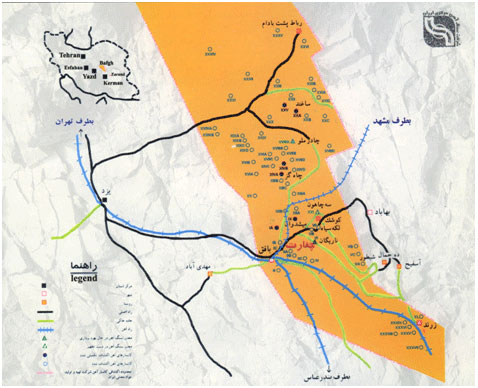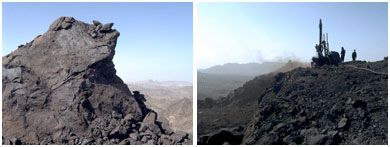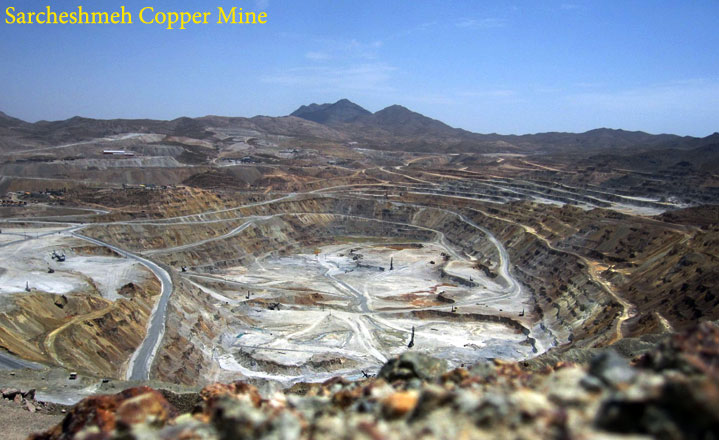The Bafq metallogenic province hosts major (1.8 Gt) Kiruna-type, sulphide-poor REE-apatite-magnetite (±hematite) deposits that are transitional to apatite-rich rocks, called “apatitites”. The deposits are hosted by volcanosedimentarysequences as well as individual volcanic rocks of dominantly rhyolite-rhyodacite composition that are part of an Early Cambrian volcanism within the Kashmar Kerman magmatic arc in East-Central Iran. The felsic volcanism is part of a felsic-mafic bimodal volcanism of alkaline character with minor andesites and rare undersaturated rocks (nephelinite-basanite) that was followed by a regional, alkali (sodic and potassic) metasomatism, formation of albiterich rocks (albitites), apatite-Fe oxide mineralization, and swarms of late diabase dykes. Multistage metasomatism resulted in the formation of synvolcanic-synsedimentary to synsedimentary epigenetic, and post-volcanic epigenetic mineralization. The ore fluids evolved from an anhydrous paragenetic association consisting of LREE-F(-Cl±OH)-apatite and monazite ± Ca-rich pyroxene, actinolite or chlorite, ±quartz, magnetite(±hematite) ± REE-Ca-rich garnet. Multistage Actinolite is the most common ore-related alteration and formed instead of pyroxene during the early-stage at lower temperatures. Chlorite formed instead of actinolite at lower temperatures. The late-stage fluids were enriched in CO2, SiO2 and HREE and formed calcite, quartz, monazite2, apatite2, allanite, and HREE minerals xenotime, bastnaesite, syncheysite, and britholite. Minor, post-oxide pyrite±chalcopyrite was followed by talc alteration, rutile, Sr-barite, and Ca-thorianite, and by chloritization and sericitization. Anhydrite ±fluorite ±Sr-barite formed with autigenic quartz and feldspars in sedimentary ores. Similar radiometric ages of the ore-related apatite, monazite, and the host rhyolites (525–539 Ma) confirms that the mineralization was coeval with the Early Cambrian high level magmatism, suggesting a direct relationship between the magma generation and the mineralization. Ore-related, large scale metasomatism within the Bafq structural zone, and the association with the bimodal volcanism with alkaline character and an alkali metasomatism indicate a tectonomagmatic control on the mineralization that was probably related to a short lived rifting stage in the Early Cambrian. In the apparent absence of Cu-Au deposits, the Bafq region can be referred as an IOA (Iron Oxide Apatite) metallogenic province.DALIRAN et al., 2010 The Bafq mining district contains >2,000 Mt of high-grade Fe ore (NISCO, 1980), which places it among the largest non-BIF type Fe ore districts of the world. This region has attracted geologists for nearly a century due to its complexity and valuable ore deposits. The Bafq mining district contains significant bodies of magnetite mineralization as reflected by 34 major magnetic targets and several non-Fe systems containingPb and Zn, Mn, U, P and REE. The Fe-oxide deposits of the Bafq region mainly consist of magnetite-hematiteapatite and host by Cambrian volcano-sedimentary sequence (also known as Saghand Formation) associated with number of felsic and mafic intrusions. These ore bodies are commonly associated with pervasively altered rhyolitic tuffs and sandstones. The origin of the Bafq Fe deposits is the subject of a long-standing debate. Among the geological and exploration reports on the region were those of Stahl (1911); Bohne (1928, 1929); Baier (1940); Kumel (1941); Diehl (1944); Walther and Kursten (1958); Venzlaff et al. (1961); Molly (1964) and Iwao and Zahedi (1966). Huckriede et al. (1962) worked on the geology of the Kerman–Bafq region and attempted to classify its Fe ores. The National Iranian Steel Corporation (NISCO) initiated several exploration projects. The results of these investigations were compiled in a series of internal reports. These investigations were oriented toward documenting exploration of the ore field by geophysical exploration and drilling. During these programs over 80 magnetic anomalies were discovered and many of these were subsequently drilled. Based on the information acquired from these works the style of mineralization and the geological setting have been documented by geologists of National Iranian Iron and Steel Corporation. Most of the early authors proposed a metamorphic origin for the Bafq Fe-apatite deposits, although some geologists who mainly worked on the NISCO projects proposed a metasomatic origin involving metamorphism, volcanic and intrusive activity. Williams and Houshmand-zadeh (1966) proposed a magmatic origin for the Choghart deposit and compared it with the Kiruna Fe ore deposits. Investigators supporting an immiscible liquid magmatic model of formation included Forster and Borumandi (1971) and Forster and Jafarzadeh (1984) who reported magnetite lava flows and magnetite-bearing pyroclastic rocks at Chador Malu and suggested a carbonatitic affinity for the Fe-oxide melt (a theme amplified in the account of the Bafq district magnetite–apatite deposits by Forster and Jafarzadeh, 1994). Jafarzadeh (1981) interpretedthe Chador Malu deposit as an explosive vent filled with magnetite melt. Samani (1988a)classified mineralisation at the Choghart mine and at anomalies 20 and 26 as being of magnetite-carbonatite type. Darvishzadeh (1983) and Darvishzadeh et al. (1996) investigated the mineralogical and geochemical characteristics of the Esfordi Fe–P deposit and noted the alkaline affinity of the igneous rocks, the presence of apatite-rich veins, the size and shape of the apatite crystals and the carbonate-rich matrix. Based on the mineralogical association of magnetite, apatite and carbonate it was concluded that there was a relationship between carbonatitic magmatism and mineralisation, although no situ carbonatites were found at Esfordi. Haghipour (1977) wrote a geological and petrological report on the stratigraphic correlation of the Bafq host rocks. He had previously suggested a close relationship between Fe ore deposits and metasomatic metamorphism in some deposits but a volcanogenic or syngenetic origin in other deposits. Similarly, Momenzadeh (1978, 1982, 1986) proposed a syngenetic submarine volcanogenic origin for Bafq region deposits based on their massive, lenticular, banded and lens-like morphology, their development within a specific lithostratigraphic unit and relation to nearby stratified Mn and Pb deposits. Daliran (1990, 1999, 2002) also concluded that hydrothermal fluids played a prominent role in the evolution of the Bafq magnetite–apatite deposits. The significance of some of this work in relation to the Esfordi Fe–P system, particularly that of Daliran (1990, 2002) and Forster and Jafarzadeh (1994) is canvassed in the discussion and conclusion chapter of this thesis.(JAMI, 2005)
Mineral Reserved in Bafgh Region
During Infracambrian, some geological activities shaped the Bafgh Volcano Sedimentary Basin. According to these activities, 3 geological iron ore deposits were formed, which are called Bafgh blocks, such as Zarand, Saghand and Robat Poshteh Badam. Potential of Bafgh deposits have been known for a long times, and there are old mine working indicating that some ore was extracted in ancient times. For the first time in 1897 a German geologist (Stahl) identified these deposits and made the geology spot mapping. There are sufficient quantities of valuable minerals such as: Iron Ore, Mg bearing Iron Ore, Apatite, Lead and Zinc in this region. The important minable ore reserves are located at Choghart, Se-Chahoun, Chahgaz, Lakk-E-Siah and North Anomaly

Distribution Map of Bafgh Area Iron Ore Deposits
|
||||||||||||
|

